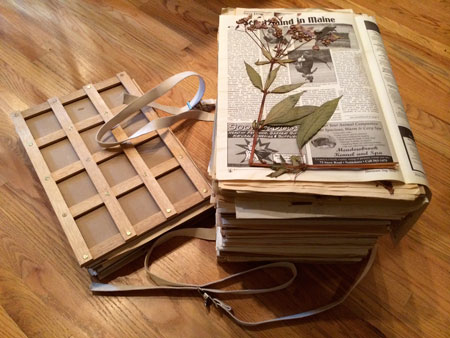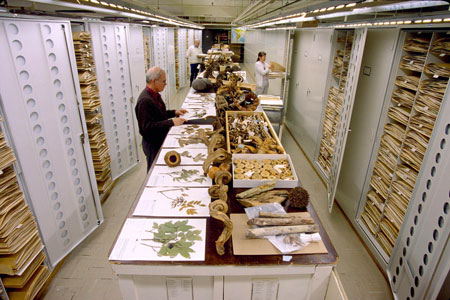Confessions of a Herbarium-Savvy Field Biologist
By Carolyn Beans
With natural history collections in decline, what's a busy researcher to do with specimens from past studies?
December 7, 2015
Macroscope Biology Botany Ecology
I have a confession. The plants I collected during my graduate work are still sitting in a plant press. Without printed labels. In my house. I graduated over a year ago. For some time the press sat tucked in a corner of my living room, topped by my cable box and router. I may own the only media console constructed with thousands of miles of driving and months of wading through waist-high weeds.

Courtesy of Carolyn Beans.
I should know better. Before graduate school, I spent a few years working in herbaria (which are plant libraries, basically), first at the Academy of Natural Sciences in Philadelphia and then at Harvard University. I helped enough researchers find the one pressed plant that propelled his or her research forward to know that the plants I have holding up my cable box could serve a far more noble purpose. A standard practice in biology when one's research involves identifying living organisms to species is to collect and preserve examples that serve as vouchers that they were named correctly. But as a researcher, even one who relied on herbarium specimens, I am all too familiar with the many ways we justify letting our voucher specimens go unaccessioned (or failing to collect them in the first place).
Who Needs My Crusty Old Plants?
I studied how an invasive species of jewelweed influenced the evolution of a closely related native plant. To find places where these plants grew together, I relied, in part, on herbarium specimens collected over the past 100 years in the northeastern United States. I also identified additional communities, including those where the morphology of the native plant made me wonder whether the two species were hybridizing. I never fully addressed that question, but I did collect vouchers of both species throughout New England. If anyone ever wanted to follow up on my work, they could start with my herbarium specimens.
As far as I know, however, no one is studying the interactions of these plants. And there are probably hundreds of collections of these species already deposited in herbaria. I'm not sure what value my additional 50 plants can add. But this uncertainty is exactly the point.
The botanists who collected and pressed flowering trees and shrubs from Harvard University's Arnold Arboretum in the early 1900s could never have known the specimens would one day be used to show that plants flower earlier in response to climate change.
The naturalists who collected in the California grasslands in the early 20th century surely didn’t imagine that scientists would one day sequence the viral RNA preserved in the leaves, and by doing so provide evidence that these viruses helped Eurasian grasses invade the community.
And few of the thousands of botanists who collected sweet potato relatives across the Americas over the past couple of centuries could have guessed that their specimens would one day be used to help breeders identify populations with novel genes that could improve the crop.
Flatten and dry a plant, stick it on some archival paper with a bit of water mixed with Elmer's glue (yes, some herbaria really use regular old Elmer's glue!), and it can outlast us all. In time, myriad uses become evident—most of which we collectors never anticipated.
Are Photos and DNA Better Than Pressed Plants?
Photographs are excellent additions to a sample, but they cannot capture the entire story when it's impossible to foresee how the story will end. Perhaps the glandular hairs at the base of a leaf will one day prove that a specimen is an entirely new species. Or the spacing between branches on a stem will suggest the point in time when two species began hybridizing. Or the width of a seed will show evidence of a significant drought. We would need a daunting number of photographs to capture a plant from every angle of potential evolutionary or ecological significance.
DNA can tell us a great deal about where a plant falls on an evolutionary tree. It may even tell us about physical or ecological traits like color, scent, and flowering time. But unless that DNA is accompanied by an actual voucher specimen, there is no way to verify a plant's true identity. If a biologist discovers a specimen with an unusual set of genes for that species, it is impossible to know whether these are truly meaningful results or whether the plant was misidentified. Furthermore, if DNA suggests that the sample is a new species altogether, a scientist cannot assign that species a name without a herbarium specimen of the plant in flower.
A botanist mounting a plant to paper takes great care to preserve it from every viewpoint. Some flowers are pressed face out; some on their sides. Some leaves are gently twisted so their undersides are visible. Extra flowers, fruit, or broken-off leaves are carefully folded into an envelope attached to the sheet. Some of this dried material can later be used for molecular studies.
Last year, an article in Science sparked a debate over whether it’s always advisable to collect voucher specimens. The authors suggested that by replacing vouchers with photographs and DNA samples, scientists could avoid adding to the extinction risk of small populations of animals and plants. Curators across the globe responded by arguing that scientific collectors are not the cause of species extinctions. They begged researchers to collect more, not fewer, voucher specimens. As Frank-T. Krell and Quentin Wheeler wrote in one response, "With millions of species threatened by extinction, it would be tragic were we left with no more than a few photographs and sequences as evidence they were once here."
Where Do I Send My Plants?
With increasing numbers of universities and museums cutting costs by closing herbaria and other natural history collections, figuring out where to deposit specimens can be complicated. Researchers who previously could place plants in their institutions' own herbaria may now need to search for a new home.

Courtesy of Chip Clark, National Museum of Natural History.
But according to Rusty Russell, the collections manager of the United States National Herbarium at the Smithsonian's National Museum of Natural History, those homes are waiting. Larger herbaria are absorbing many of the smaller ones and are still actively accepting newly collected plants. "It's the responsibility of major collections like the Smithsonian to make sure that orphaned collections are not lost to science. We may not keep all of these collections ourselves, but we grab them before they get thrown out and then put them in other herbaria where they are better served," he says. And when botanists submit new plant specimens, Russell says that the Smithsonian rarely turns anything away as long as the specimens are well labeled and well prepared.
The Smithsonian isn't the best place to deposit every voucher. Researchers should consider where the people who are most likely to use the plants can most easily access them, and then contact the collection managers at those herbaria. Specimens from ecological collections that involve sampling the same species within a single county or state are most valuable to the herbaria closest to that region. Specimens from large-scale biodiversity surveys are often collected in duplicates. One duplicate of a species might go to the herbarium associated with the collector's institution (if there is one). Another could stay within the host country, and another could be sent to whatever herbarium already has the largest collection of that species, so that a botanist interested in studying it could travel to one central location for research.
The bottom line, according to Russell: "Every single study that involves a plant species needs to be vouchered because you can't reproduce it without original material. You can describe a plant in a million words and it's still not as good as the plant itself."
A Rightful Place for Raw Data
Before I could publish two of my dissertation chapters, the journal required that my raw data be deposited in a database where any reader could access it. This policy is part of a movement within the scientific community to safeguard and share raw data. By making all of my spreadsheets of plant height, seed number, and flower size publicly available, I can greatly assist those who might want to reproduce my results or build on my findings for future studies.
Plant specimens are also an invaluable form of raw data. Many journals require that systematic or phylogenetic studies be supported by voucher specimens deposited in a herbarium. But for other plant studies, it's often up to the researchers to decide what, if anything, to do with their samples. When we chose not to deposit our plants in a permanent collection, we contribute to the huge amount of lost raw data in science.
It’s time for my plants to join a herbarium collection. Maybe someone will use them to pursue my own unanswered research questions. More likely, the plants will sit in a cabinet for decades or more, untouched, until one day, just maybe, a scientist will pull them out and think, "Yes! This is exactly what I was searching for."
American Scientist Comments and Discussion
To discuss our articles or comment on them, please share them and tag American Scientist on social media platforms. Here are links to our profiles on Twitter, Facebook, and LinkedIn.
If we re-share your post, we will moderate comments/discussion following our comments policy.